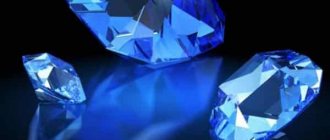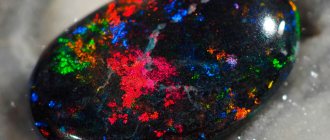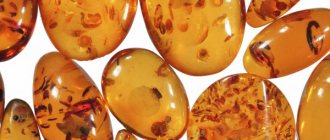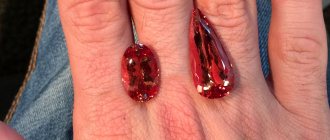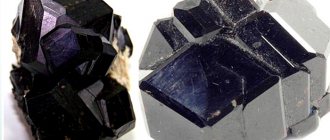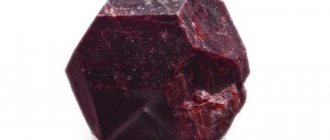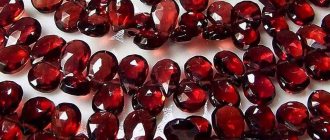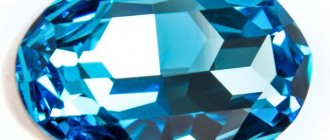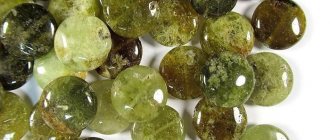Garnet is a semi-precious stone that has strong energetic power and dazzling beauty. It got its name due to its similarity to pomegranate seeds. Most people are accustomed to thinking that a gem can only be colored in bright red shades, but this is far from the case. Nature has not been greedy for the mineral of flowers, so you can find orange, pink, green, yellow, brown, purple and even black varieties of the crystal.
Due to the fact that garnet is a fairly common mineral, and even belongs to the group of semi-precious stones, they have learned to fake it very well and sell it at the price of natural stones.
To know how to distinguish a natural stone from a fake or synthetic one, we suggest you familiarize yourself with our recommendations and the basic properties of the mineral.
What does a real mineral look like?
Until relatively recently, only red pebbles similar to pomegranate seeds were called garnet. However, today a whole group of minerals is known under this name, which can look completely different.
Appearance of pomegranate and its price
Today, the garnet group includes 14 varieties of the mineral, the most famous of which are:
- Pyrope. This is the same classic red mineral. It occurs quite often in nature, therefore it is more widespread and known.
- Almadin. Another common mineral of this group. Its color can range from red to purple to dark brown.
- Rhodolite. It is found much less frequently than other varieties. It has an amazingly beautiful rich pink color. There are also specimens that shimmer in all shades of lilac and crimson.
- Spessartine is a variety that naturally has a reddish, pink and even brownish-yellow color.
- Andradite. Distributed quite widely. The color palette ranges from deep burgundy to orange, yellow and even grass green.
- Grossular is more similar in appearance to gooseberries than to pomegranates, but has the same properties, so it is included in this group.
- Uvarovite. Another green garnet with an emerald tint. It is quite rare.
- Hessonite. The color of this variety can vary from orange to honey yellow.
- Garnet chameleon. The rarest and most amazing type of pomegranate. Just like alexandrite, it can change its shade to a significant extent. Thus, in natural light it acquires a green-blue color, and in artificial light it becomes violet-red.
The cost of a garnet depends on a number of factors, including its color, distribution, cutting method and quality. Among the varieties of garnet there are precious and semi-precious stones, respectively, and the price for them can be either average or very high (almost on par with diamonds).
Medicinal properties
In the Ancient East, healers believed that pomegranate was suitable for protecting its owner from a variety of misfortunes. It was considered the best antidote, protected a person from the plague, and was able to overcome heat and fever. In the Middle Ages, when going on the Crusades, knights took with them a garnet amulet, which not only gave strength in battles, but, according to legend, could also stop severe bleeding. Residents of India still believe that such decoration can greatly improve health. And in the times of Ancient Rus', the gem helped pregnant and giving birth women.
Artificial pomegranate
Back in the first half of the 20th century, garnets began to be synthesized in laboratory conditions, producing fairly large specimens. However, the first experiments in this direction were so economically expensive that the cost of artificial stones significantly exceeded the cost of natural minerals.
What are fake garnets made from?
The first mistakes did not stop scientists, and research in the field of growing garnets continued until, in the late 40s of the last century, scientists M. Yoder and M. Keith discovered groups of yttrium garnets in some natural stones. Subsequently, it was decided to use this element for the synthesis of artificial minerals.
Already in 1951, a description of a new artificial stone appeared, which differed from natural garnet in increased hardness, refractive index and dispersion close to diamond. The resulting pebble is called yttrium aluminum garnet.
Subsequently, scientists also learned to create gadolinium-gallium and yttrium-iron garnets. However, for a long time, artificially grown stones were used exclusively in industry. They began to be used in jewelry relatively recently.
Pomegranate imitations - what materials are used
Fraudsters began making their first attempts to counterfeit garnets many hundreds of years ago, when the stone gained sufficient popularity and was in stable demand. In the Czech Republic, for example, where one of the country's symbols is the Czech pomegranate, the scale of crimes related to counterfeiting has reached a colossal level. Stores sell stones, of which every second is artificial.
Artificial stones are most suitable as materials for simulating minerals. It could be cubic zirconia dyed in the desired color - once grown in one of the laboratories of the USSR. But even this option seems costly to scammers, so they mostly use cheaper substitutes: glass and plastic. Moreover, they are trying to replace gems of all colors with glass, imitating the shine and shades.
Moreover, for the large-scale production of fake garnets, glass production was taken to a new level. Now this is a special “garnet glass” that replaces genuine minerals in jewelry and souvenirs.
How to recognize a fake
In most cases (with the exception of very cheap glass or plastic fakes), synthetic garnet has improved properties and a more beautiful appearance. However, despite this, natural minerals are still much more valuable. Therefore, when buying jewelry with garnet, it is worth knowing how you can distinguish a real natural mineral from a stone created artificially.
Visual analysis
In order to identify a fake, you need to know what the original looks like. One of the first characteristics that help to visually distinguish a garnet from a fake is its size.
Real grenades are never big. And taking into account that during processing they lose a little more of their volume, the maximum size of a cut stone, indeed, does not exceed a pomegranate seed. Therefore, when you come across a piece of jewelry inlaid with a large stone, you can say with confidence that the mineral is artificially created.
Color is the second sign that can indicate a fake. The artificial garnet stone will have a smooth, evenly distributed color throughout the stone. Natural, on the contrary, can “boast” of soft tints of various shades. To see this, just take a pebble and look through it into the light.
The mineral itself is also heterogeneous; small inclusions and dark spots can be seen in it. But the presence of air bubbles inside will “tell” that the role of garnet is played by ordinary glass. In artificially grown stones, in turn, upon examination, one can notice rings and lines along which the crystal grew.
You can also determine the authenticity of a garnet by its shine, or rather, its absence. A real stone, like any mineral, has a soft, pleasant shimmer. But the fake will shine brightly.
In addition, natural garnet differs from synthetic ones in the internal play of light. A similar effect is created due to the uneven passage of light rays that are refracted at the edges. For artificial and even the most skillful fakes, such a “miracle” is simply not available.
Mechanical impact
If it was not possible to visually determine the authenticity of the stone, you can use its characteristic properties, which are easy to check:
- Thermal conductivity. All minerals have poor thermal conductivity. Therefore, holding a natural stone in your hands, you can feel that it heats up quite slowly from the warmth of your hands. For the “purity of the experiment,” you can simultaneously pick up glass and mineral and compare the rate of their heating.
- Its hardness will help you distinguish a garnet from a cheap fake made of glass. If you run a real stone across a glass surface, scratches will appear on it, while the mineral itself will remain intact and unharmed. In this way it resembles a diamond, to which it is close in hardness. This method of determination is not applicable to artificially grown garnets, since their hardness is even higher than that of a real gem.
- Magnetization. The chemical composition of a natural mineral gives it the ability to magnetize. You can check this property by placing a pebble on a jewelry scale (on top of a dense layer of plastic, cork or other material that is insensitive to a magnet) and bringing a piece of magnet to it. If there is a pomegranate on the bowl, its weight will begin to fluctuate (decrease). An artificial stone will not react in any way to the approach of a magnet.
- Another way to test real almandine at home is to try to electrify the gem. This “trick” will work with the real thing, but not with a piece of glass. To conduct the experiment, it will be enough to rub the pomegranate on a downy scarf or your own hair. If after this it begins to attract hair or lint from a scarf, then there is no doubt about the authenticity of the stone.
If the selected pebble has successfully passed all the tests, but doubts about its authenticity remain, it makes sense to contact a specialist for an expert assessment.
Varieties
The crystal structure of garnets is identical, but the chemical composition may differ noticeably. It is this that is the reason for the diversity of this gem. Jewelers distinguish the following varieties of garnet:
- Uvarovite. It is a rare variation of pomegranate, distinguished by its bright green hue.
- Grossular. Usually has a yellow or green color.
- Almadin. A popular type of pomegranate, it has a classic red color, sometimes shimmering with brown and crimson shades.
- Demantoid is a very expensive and rare green garnet.
- Spessartine. It is distinguished by its uniform golden-orange color among rare gems. Usually it has a pink tint.
- Andradite. An unusual variety of pomegranate, it comes in brown, yellow and crimson colors.
- Melanitis. Black garnet is valued for its medicinal properties.
- Majorite. The rarest purple garnet.
The stone most often seen on jewelry store shelves is pyrope; it is also called “red garnet.” Some specimens may have an orange or purple sheen. The price of a stone directly depends on its color, because it indicates the scale of its distribution.
Who is suitable according to their zodiac sign?
It is generally accepted that an artificial stone is suitable for any zodiac sign. Each person can independently fill the crystal with the energy that he needs (see how to do this in the previous section).
According to some astrologers, the magical properties of cubic zirconia of different colors are distributed according to the elements:
- Air (Libra, Gemini, Aquarius) - yellow.
- Fire (Leo, Aries, Sagittarius) - red.
- Earth (Virgo, Taurus, Capricorn) - black, green.
- Water (Cancer, Pisces, Scorpio) - blue, white.
What effect will the stone have on each zodiac sign?
- Aries - cubic zirconia will influence the increase of his intelligence, the desire for discovery. In addition to red cubic zirconia, yellow and green are suitable for this sign; they help reduce the degree of temper and excessive emotionality.
According to the horoscope, cubic zirconia is most suitable for Aries, whose hardness of character is similar to the hardness of this mineral.
- Taurus - with the help of the stone, the energy balance will be normal, which gives confidence in one’s own abilities.
- Gemini will get rid of excessive talkativeness, concentration and the mood for practical activities will increase. In addition to yellow stones, transparent and black cubic zirconia may be suitable.
- Cancer especially needs a strong protective amulet. It would be good if it was made of silver with an insert of transparent, blue or blue cubic zirconia. Such stones help increase mental activity, protect health, and add confidence.
- Leo - a red crystal in a gold frame will help to “extinguish” outbursts of anger, which will promote harmony in the family.
- Virgo is characterized by both practicality and mysticism. White, lavender and green stones are suitable for a combination of these character traits.
- Libra - in addition to yellow cubic zirconia, dark blue and turquoise are also suitable for representatives of this sign. They promote mental balance, improved mood, and tranquility. But astrologers do not recommend artificial stones for people born from October 14 to October 23.
- Scorpio - white and blue stones will help lower the “degree” of emotions and find peace, which will greatly strengthen the family.
- Sagittarius - in addition to red cubic zirconia, blue stones are also suitable for him. They will help direct the strong energy of this sign towards creation rather than destruction. Emotions and feelings will become calmer, and the person will discover many new and interesting things.
- Capricorn - astrologers recommend dark green and dark gray stones for representatives of this zodiac sign. Gems of muted colors will help people increase self-esteem and believe in their strength and the possibility of happiness.
- Aquarius - in addition to yellow cubic zirconias, transparent, blue, and blue ones are also suitable for him. They will promote the pursuit of knowledge and success.
- Pisces - in addition to white, shades that resemble sea water - blue and green - are suitable for them. With the assistance of such cubic zirconia, intuition will develop and a desire to learn new things will appear.
Talismans and amulets
Since ancient times, people have used amulets made from this gem.
For example, every traveler tried to take a garnet ring or pendant on the road. The pomegranate is considered an amulet that can both preserve and win the love of another person. Scandinavian legend says that the miniature Ogren, having fallen in love with Freya, the goddess of love, forged a beautiful necklace in order to achieve her favor.
Another property attributed to pomegranate is especially important for men. It symbolizes masculinity, fortitude, and courage.
Many warriors wore jewelry made from this mineral, as it was considered a strong amulet that protected against wounds and death in battle. They inlaid weapons, armor, and helmets. And during the Crusades, almost every knight had a ring with a garnet, designed to protect it in battle.
Products made from garnet have very strong energy, because of this you should not wear it continuously, you should remove it from time to time and let it “rest”.
Other uses of stone
Garnets were often present in the ceremonial clothes of courtiers, in the outfits of noble people, and even in the decoration of palaces. For example, the Chamber of Facets in the Kremlin is entirely inlaid with this very mineral. The famous jeweler Faberge was very fond of this mineral: many of his boxes and precious toys were made using garnet fragments.
These gemstones are widely used in various industries. Thus, garnet is an excellent ferromagnet, which is why it is used in electronics. It is also added to some building mixtures. Parts of optical systems and lasers can be made from this mineral (as well as from ruby).
Features of YAG
Yttrium-aluminum garnets are not completely identical to natural garnets:
- hardness - 8.5 on the Mohs scale (natural - 6.5-7.5 points);
- refractive index - 1.833 (for natural ones - 1.675-1.890);
- density - 4.55 (for natural ones - 3120-4300).
The Kyropoulos method is used to grow YAG: it allows one to obtain large crystals of high jewelry quality. Synthetic garnets are not inferior to natural ones in purity and other characteristics.
Yttrium-aluminum garnets are little known on the Russian market. But interest in them is growing, which means demand will also grow.
Price
Cubic zirconia is not a precious stone, as it is not at all rare. Its price is quite affordable for most people.
The cost of jewelry with cubic zirconia depends on:
- stone quality;
- values of metal for the frame.
On the global jewelry market, the average price of cubic zirconia per 1 gram is:
- small colorless or transparent crystals - $0.5;
- colored, similar to precious stones - $1-3 (if similar to ruby, sapphire and blue topaz - twice as expensive);
- large, multi-colored, and also imitating diamond placers - $3-5.
Examples of prices for jewelry with cubic zirconia in Russian online stores:
- silver earrings (925 sterling silver) - RUB 2,790;
- silver bracelet (925 sterling silver) - RUB 3,990;
- earrings made of gold with green cubic zirconia (gold purity 585) - 6,350 rubles;
- gold ring (gold purity 585) - RUB 9,830;
- gold pendant with green and blue cubic zirconia (gold purity 585) - RUB 12,890.
Place of Birth
Garnets are mined all over the world. Their deposits are found on almost all continents, with the exception of Antarctica. Pomegranates are found in Russia, the USA, Germany, Mexico, Australia, Zambia, Brazil, India, Sri Lanka and some other countries.
In Russia, the largest deposits are located in Yakutia (very rare fiery red pyropes are mined there), on the Kola Peninsula, Chukotka and the Urals. It is the Ural mines that supply jewelers with a significant portion of green uvarovite.
In the USA, on the border of the states of Colorado, Utah, New Mexico and Arizona, one of the most amazing types of this gem is mined: “Ant”, or “Arizona” garnet.
These tiny stones, no more than one and a half carats, are brought to the surface by ants when building their “palaces”. The surprising thing is that, despite all the efforts, it was not possible to detect these bright red granules using the mine method.

